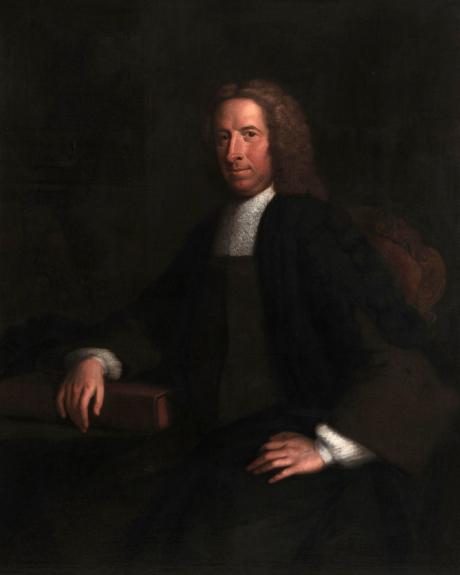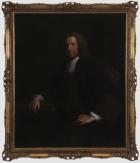gilt wood and composition frame, lined with linen and restretched on 19th century stretcher, scattered retouch, crackle.
By Descent to Charlotte Caldwell
Engraved J. Bayly, pubd 1769
Thorpe, John (1682–1750), physician and antiquary, eldest son of John Thorpe, landowner, and his wife, Ann, sister and coheir of Oliver Combridge, of Newhouse, Penshurst, Kent, was born at his father's house, Newhouse, on 12 March 1682. His father owned a good estate in the Kentish parishes of Penshurst, Lamberhurst, Tonbridge, and Chiddingstone. He attended the grammar school at Westerham, where the master was Thomas Manningham, afterwards bishop of Chichester. On 14 April 1698 he matriculated from University College, Oxford, whence he graduated BA at Michaelmas 1701, MA on 27 June 1704, MB on 16 May 1707, and MD in July 1710. Elected a fellow of the Royal Society on 30 November 1705, he was then living in Ormond Street, London, near his friend Richard Mead, the physician. For some years he assisted another friend, Sir Hans Sloane, in publishing the Royal Society's Philosophical Transactions, which included on 24 July 1704 a letter to Sloane on worms in the heads of sheep.
On 5 May 1715 Thorpe married Elizabeth, daughter of John Woodhouse of Shobdon, Herefordshire, at St Benet Paul's Wharf, London. In the same year he settled as a physician in Rochester, where he and his wife lived within the precincts of the cathedral. He developed a considerable practice and gave free medical aid to the poor in his district. He was noted in the 1740 medical diary of Dr Jeremiah Cliff of Tenterden. In 1734 he became a freeman of the city of Rochester. Devoting himself to the study of the architecture, antiquities, and the history of the county of Kent, he made numerous manuscript extracts relating to Kent from central archives; his papers eventually made their way to the Society of Antiquaries. The Scotgrove chantry, part of the long defunct manor of Scotgrove, in the parish of Hartley, was rescued from oblivion by Thorpe's enquiring mind in 1728. His collections were published posthumously in 1769 by his son, John Thorpe, in folio, under the title of Registrum Roffense. The book contains numerous charters (all given in full), monumental inscriptions, and other historical materials.
Thorpe was generous in his historical assistance to Thomas Hearne, Browne Willis, and other scholars, and he edited the ‘Itinera Alpina Tria’ of Scheuchzer. He improved the management and finances of Rochester Bridge in his role as a warden and assistant of the bridge from 1731 until his death, serving as senior warden in 1733 and 1742 and as junior warden in 1746. In 1731 he published A List of the Lands Contributory to Rochester Bridge. He compiled the earliest surviving record of its archives, had the accounts bound in leather, and presented to the Bridge Chamber a splendid set of chairs and staves suitable for the senior and junior wardens. In a useful report he examined in detail repairs to the bridge undertaken during the previous three centuries. A mass of material about the bridge occupies four volumes in the Thorpe MSS in the library of the Society of Antiquaries. In 1733 he published a collection of statutes of Richard II, Henry V, Elizabeth, and Anne, concerning the bridge. Thorpe died on 30 November 1750 at Rochester and was buried in the church of Stockbury, Kent, in which parish he had purchased a house and land called Nettlested, once owned by the family of the antiquary Robert Plot.
Norman Moore, rev. John Whyman DNB
According to Walpole he was born circa 1672. Father of John Wollston jr, (who was also a portrait painter and emigrated to America.), he practiced in London and died impovrished in the Chaterhouse July 1749. He married the daughter of an attorney named Green and had several children .



